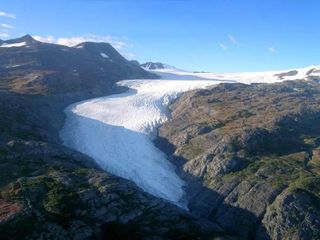
World's Glaciers Have New Size Estimate

The relatively small glaciers that drape the planet's mountains will play an important role in future sea level rise, according to a new study that estimated glaciers' collective size.
Researchers calculated the ice thickness for 171,000 glaciers worldwide, excluding the Greenland and Antarctic ice sheets, which hold the bulk of Earth's frozen water. Through a combination of direct satellite observations and modeling, they determined the total volume of ice tied up in the glaciers is nearly 41,000 cubic miles (170,000 cubic kilometers), plus or minus 5,000 cubic miles (21,000 cubic km).
If all the glaciers were to melt, global sea levels would rise almost 17 inches (43 centimeters), the scientists found.
Improved estimate
The study, published in the Oct. 11 issue of the Journal of Geophysical Research, is an improvement on previous estimates of the global ice volume because it uses a physical approach, said lead study author Matthias Huss, a glaciologist at the University of Fribourg in Switzerland.
The glacier count comes from the recently released Randolph Glacier Inventory and global topography from NASA satellite data.
"To date, the volume of glaciers was only estimated using very simple empirical equations with high uncertainties," Huss told OurAmazingPlanet in an email interview. "Our new method not only provides an estimate of the ice volume, but allows calculating local ice thickness on a fine grid for each of the 200,000 glaciers worldwide," he said. [Image Gallery: Glaciers Before and After]
Sign up for the Live Science daily newsletter now
Get the world’s most fascinating discoveries delivered straight to your inbox.
Predicting sea level rise
Compared with the potential sea level rise from the Greenland and Antarctic ice sheets, the volume of land-based glaciers is relatively small, Huss said. For example, completely melting the Greenland ice sheet would add 23 feet (7 meters) to the average global sea level, according to a 2007 report by the Intergovernmental Panel on Climate Change (IPCC).
But mountain glaciers are still a concern because they "react very fast to higher temperatures and a considerable retreat is very likely in the next decades," Huss said.
Knowing the thickness and total volume of glaciers worldwide is essential for modeling the response of glaciers to climate change, said Valentina Radic, a glaciologist at the University of British Columbia who was not involved in the study. "This study helps to improve our projections of what will happen to the glaciers in the near future," Radic told OurAmazingPlanet in an email interview.
However, Radic notes that less than 1 percent of glaciers in the world have measured ice thicknesses, so it's hard to validate the study's estimates. (Huss calibrated his method in the European Alps, where scientists surveyed the ice by dragging a radar instrument over the glacier's surface to help determine the ice's thickness.)
"One needs to keep in mind that each glacier is unique – so a model that works well in one region may not be applicable in the other. It is hard to say how correct the estimates are, but the method is much more physically-based than any method so far applied on a global scale," Radic said.
Huss and his colleagues plan to next apply their model to predicting how the thousands of glaciers will react to future global warming.
Reach Becky Oskin at boskin@techmedianetwork.com. Follow her on Twitter @beckyoskin. Follow OurAmazingPlanet on Twitter @OAPlanet. We're also on Facebook and Google+.

Most Popular

